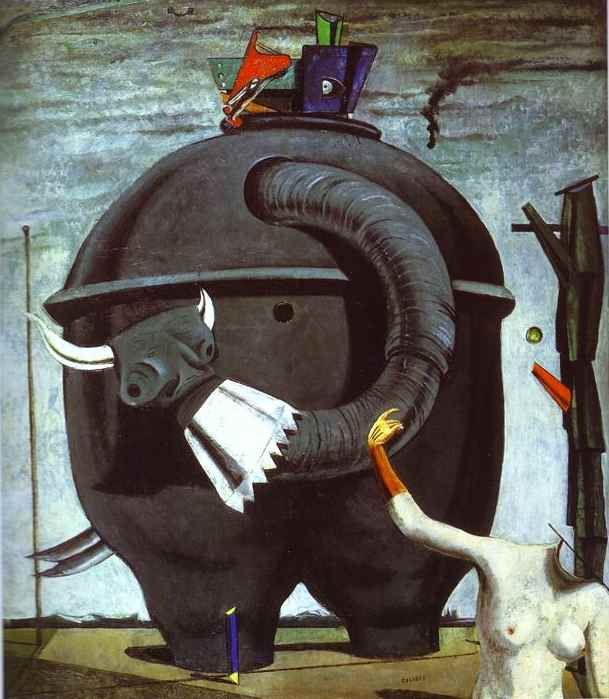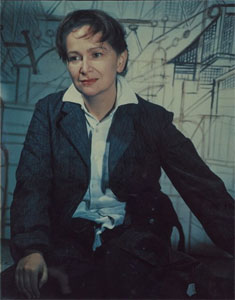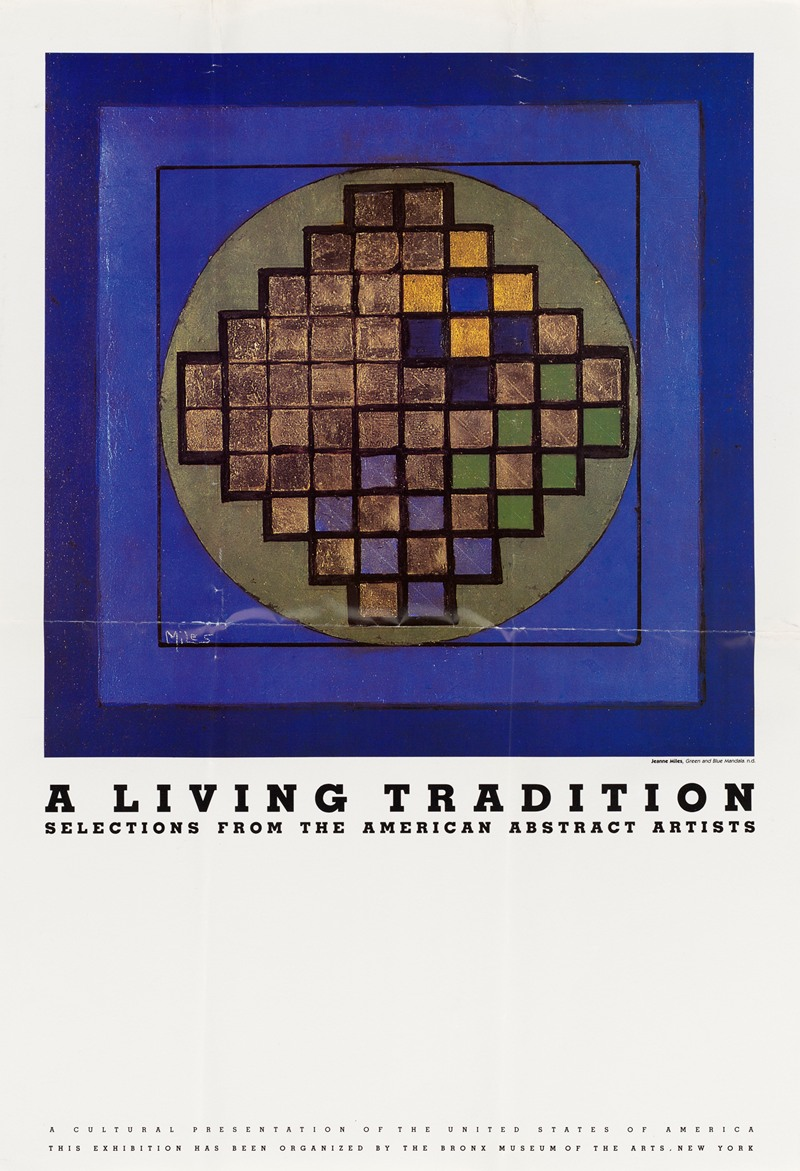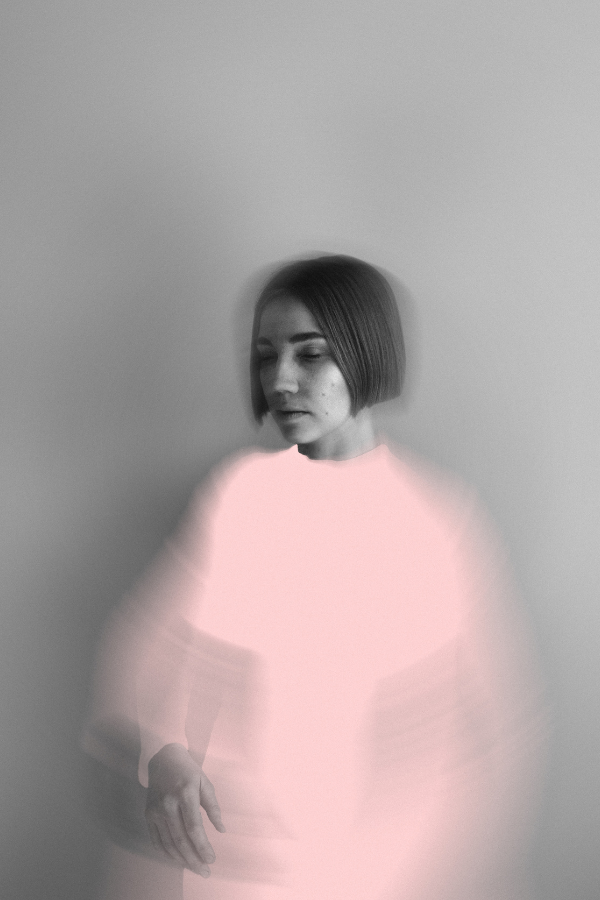

Hedda Sterne: Her Work, Life, and Enduring Influence
Summary
Reflection Questions
Journal Prompt
Hedda Sterne’s work recently broke records at Sotheby’s Modern amid otherwise unimpressive sales from pieces on the auction block. But who was Hedda Sterne? Hedda Sterne, often regarded as a pivotal yet under-recognized figure in the New York School of Painters, presents a compelling case study in the narrative of modern art. Despite her association with the influential group of Abstract Expressionists known as “The Irascibles,” Sterne’s work eludes easy categorization, marked by its distinct evolution and stylistic diversity. In this article, we will explore Sterne’s artistic journey, noting her significant contributions to modern art and examining the enduring influence of her oeuvre on contemporary artistic discourse. In doing so, we will shed light on the nuanced complexities and the broader cultural implications of her legacy within the current art world and art history.
Early Life and Background
Hedda Sterne was born in 1910 in Bucharest, Romania, into a context that was both culturally rich and politically tumultuous. Her upbringing in Romania, during a period marked by rapid modernization and social change, significantly influenced her early perspectives on art and life.
The vibrant cultural milieu of Bucharest, coupled with the intellectual environment fostered by her family, provided Sterne with a foundation steeped in European intellectual and artistic traditions. This early exposure played a crucial role in shaping her artistic sensibilities.
Art History Education
Romanian-born American artist studied art history and studio art at the University of Bucharest in Romania. Born in Bucharest in 1910, she was exposed to a rich cultural and artistic environment from an early age. Her formal education at the University of Bucharest provided her with a foundational understanding of art and art history, which played a significant role in her development as an artist.
This academic background, coupled with the vibrant artistic scene in Europe at the time, influenced her early artistic endeavors and her eventual move towards Abstract Expressionism after she emigrated to the United States. Sterne’s education in art history not only informed her own artistic practices but also provided her with a broad perspective on art, allowing her to engage with various styles and movements throughout her career.
Early Influences and Exposure to European Art Movements


Sterne’s formative years were also a time of significant artistic evolution in Europe. She was exposed to a range of European art movements, including Surrealism and Dadaism, which were radically transforming the landscape of visual arts.
These movements, characterized by their avant-garde approach and challenge to traditional artistic norms, resonated with Sterne and would later influence her diverse artistic explorations. Her early works exhibited a clear reflection of these movements, particularly the surreal and abstract elements that would become a staple in her later pieces.
Emigration to the United States to Escape World War II
The outbreak of World War II marked a turning point in Sterne’s life. The rising tide of fascism and the impending dangers it posed, especially to Jewish families like hers, necessitated a departure from her homeland. In 1941, Sterne emigrated to the United States, a move that not only ensured her safety but also ushered her into a new phase of her artistic career.
This transition to the United States opened up new horizons for Sterne, placing her at the center of a burgeoning art scene in New York and allowing her to engage with a completely different set of artistic influences and communities. Her arrival in New York marked the beginning of a significant chapter in her life, both personally and as an artist, setting the stage for her involvement with the New York School and her subsequent impact on modern art.
Artistic Career in the United States
Upon arriving in the United States, Hedda Sterne encountered an art scene in New York that was vibrant, diverse, and in the midst of significant transformation. The early 1940s in New York were marked by the emergence of Abstract Expressionism, a movement characterized by its focus on spontaneous, abstract forms and emotional intensity.
Sterne’s transition into this environment was both challenging and invigorating. She found herself navigating a new cultural landscape, one that was rapidly moving away from the European avant-garde traditions that had shaped her early artistic endeavors. Adapting to this milieu, Sterne began to integrate the expressive, abstract qualities of the New York scene into her work, while maintaining her unique perspective and style.
Sterne’s involvement with the Abstract Expressionist movement was significant, particularly as she was the only woman in the famous “Irascibles” photo. This group, which included prominent artists like Jackson Pollock and Willem de Kooning, was known for its collective stance against the conservative policies of the art establishment.
Sterne’s inclusion in this group was a testament to her artistic prowess, but it also highlighted the gender dynamics at play within the art world at the time. Despite her presence among these influential artists, Sterne often felt marginalized and was keenly aware of her status as an outlier, both as a woman and in her approach to art.
Sterne’s artistic style distinguished her from her contemporaries in several ways. While many Abstract Expressionists embraced a more gestural, action-oriented approach to painting, Sterne’s work was characterized by a more contemplative, structured form of abstraction.
Her paintings often incorporated architectural and geometric elements, reflecting her ongoing interest in the relationship between space, form, and perception. This distinct approach set her apart from the more emotive and often chaotic styles of her male counterparts.
Moreover, Sterne’s work frequently eschewed the angst and turmoil that were prevalent themes in the works of other Abstract Expressionists, instead conveying a sense of serenity and balance. This stylistic distinction not only underscored her individuality within the movement but also contributed to the broader tapestry of artistic expression during this influential period in American art.
Evolution of Artistic Style
Hedda Sterne’s artistic style was marked by a continuous evolution, showcasing her ability to traverse various movements and mediums with a distinct flair. Initially influenced by European Surrealism, her early works displayed a predilection for dream-like imagery and abstract forms. This surrealist influence laid the groundwork for her later explorations in Abstract Expressionism. In the United States, Sterne’s style evolved as she assimilated the expressive freedom characteristic of Abstract Expressionism while maintaining a unique approach that distinguished her from her peers.
Notable Works and Series
Sterne’s oeuvre is a testament to her versatility, encompassing a wide range of subjects and styles. Among her most notable works are the New York cityscapes and industrial-themed paintings. These pieces reflect her fascination with the urban landscape and industrial machinery, often depicting them in a manner that borders on abstraction yet retains a sense of the recognizable. The cityscapes, in particular, offer a unique perspective on New York, combining elements of abstraction with architectural precision, thereby capturing the essence of the city in a manner that is both emotive and structurally coherent.
Techniques and Artistic Philosophies
The diversity in Sterne’s work is also evident in her exploration of various mediums. While primarily known for her paintings, she also experimented with drawing, printmaking, and sculpture, demonstrating a comprehensive approach to artistic expression. Her techniques varied widely, ranging from the use of traditional oil paints to incorporating unconventional materials and methods. This adaptability not only speaks to her technical skills but also to her willingness to push the boundaries of conventional artistic practices.
Sterne’s artistic philosophies were deeply rooted in her views on perception and reality. She often emphasized the importance of seeing the world in new and different ways, a philosophy that is clearly reflected in her work. Sterne believed in the transformative power of art, viewing it as a medium through which the complexities of perception and existence could be explored and expressed. This approach underpinned much of her work, driving her continual experimentation and her pursuit of new modes of artistic expression. In her journey across different styles and mediums, Sterne consistently sought to challenge the viewer’s perception, inviting them to engage with her art on a level that transcended mere aesthetic appreciation.
Sterne’s Unique Position in the Art World


Hedda Sterne’s career in the predominantly male-dominated field of Abstract Expressionism in mid-20th century America was marked by a distinct set of challenges and opportunities. As a woman artist in an era when female painters were often marginalized, Sterne navigated a complex landscape. Her presence in significant art circles, such as the group of artists known as “The Irascibles,” underscored the challenges she faced in gaining equal recognition.
Despite her evident talent and unique perspective, Sterne’s work was frequently overshadowed by her male counterparts, a reflection of the broader gender biases prevalent in the art world at the time. Nevertheless, these challenges also presented opportunities for Sterne to carve out a unique niche for herself, allowing her to develop a distinctive artistic voice that was both reflective of and distinct from the prevailing trends of her era.
Relationships and Interactions with Other Prominent Artists of Her Time


Sterne’s interactions with other prominent artists of her time were an integral part of her artistic journey. While she was closely associated with the Abstract Expressionists, her relationships with these artists were nuanced.
Sterne often expressed a sense of detachment from the group, preferring to maintain her independence rather than being categorized under a single artistic movement or style. Her interactions with fellow artists were marked by mutual respect but also by her steadfast commitment to her individual artistic path. This independence is evident in her distinctive approach to art, which, while resonant with the broader movements of her time, always retained a unique character.
An analysis of why Sterne’s work was overshadowed in her time reveals a confluence of factors. The art world’s gender biases played a significant role, often relegating women artists to the periphery. Additionally, Sterne’s reluctance to conform to a single style or movement, while integral to her artistic integrity, may have contributed to her being less recognized compared to artists who were seen as epitomizing specific styles.
Her commitment to maintaining artistic independence, though it allowed her to explore a diverse range of themes and techniques, also meant that she did not benefit from the kind of group identity that helped elevate the profiles of her male contemporaries. This commitment to artistic freedom, while it may have limited her immediate recognition, has, in retrospect, contributed to a growing appreciation of her work in more recent times, as contemporary art discourse increasingly values diversity and individual expression.
Association with Betty Parsons Gallery
Hedda Sterne was represented by the Betty Parsons Gallery. Betty Parsons was a prominent art dealer in New York and her gallery played a crucial role in promoting and showcasing the works of Abstract Expressionist artists. Parsons was known for her keen eye for emerging talent and her dedication to avant-garde art, and she was instrumental in bringing attention to many artists of the New York School, including Jackson Pollock, Mark Rothko, and Barnett Newman.
Hedda Sterne’s association with the Betty Parsons Gallery was significant for her career. Being represented by such a prestigious and influential gallery not only provided Sterne with greater visibility in the art world but also placed her in the company of some of the most influential artists of the time. This affiliation helped in solidifying her position within the American art scene, especially during the mid-20th century when Abstract Expressionism was gaining prominence.
Later Life and Work
In her later years, Hedda Sterne’s artistic focus underwent notable changes, reflecting both her personal evolution and shifting perspectives on art. While her earlier works were characterized by their engagement with Abstract Expressionism and themes of urbanity and industrialization, her later pieces displayed a turn toward more introspective and metaphysical subjects.
This shift was marked by a softer, more fluid style, often incorporating organic forms and a subtler color palette. Sterne’s later paintings and drawings suggested a contemplative engagement with nature and existence, a departure from the more structured and geometric compositions of her middle period.
This evolution in style and focus is indicative of Sterne’s continued willingness to explore new artistic territories, unconstrained by her previous successes or established artistic identity.
Recognition and Retrospectives: Rediscovery of Her Work by Newer Generations
The later years of Sterne’s career were also marked by a gradual rediscovery and appreciation of her work by new generations of art enthusiasts and scholars. This renewed interest led to several retrospectives and exhibitions that showcased the breadth and depth of her artistic contributions.
These events helped in re-establishing Sterne’s position within the canon of modern art and highlighted her role as a pioneering figure in the development of abstract and expressionist art in America. Notably, these retrospectives often emphasized the unique qualities of her work, distinguishing her from her contemporaries and underscoring her significance as an independent and innovative artist.
Sterne’s final years were spent away from the public eye, as she increasingly withdrew from the art world due to health issues. Despite this retreat, her legacy continued to grow, cementing her status as an influential figure in the history of modern art. Her diverse body of work, marked by constant evolution and a commitment to personal artistic expression, has continued to inspire and influence artists and art connoisseurs.
The late recognition and resurgence of interest in her work have ensured that Sterne’s contributions are not only remembered but also re-evaluated, providing valuable insights into the often-overlooked narratives and perspectives in the art world. Her legacy is one of resilience, innovation, and the relentless pursuit of artistic authenticity, serving as an enduring testament to her life and work.
Enduring Influence and Contemporary Relevance
The influence of Hedda Sterne’s work on modern artists is both subtle and significant, resonating through various facets of contemporary art. Sterne’s approach, characterized by a continuous exploration of new ideas and techniques, serves as an inspiration for artists seeking to break away from rigid stylistic constraints.
Her ability to traverse different artistic movements while maintaining a unique voice has been particularly influential, offering a model for artists who wish to engage with diverse styles without being confined by them. Modern artists, especially those who challenge conventional boundaries of artistic expression, often draw upon Sterne’s example of innovation and adaptability. Additionally, her exploration of themes such as urbanity, nature, and existentialism continues to find echoes in contemporary works, underscoring the timeless relevance of her artistic inquiries.
Her Contribution to Challenging Gender Norms in the Art World
Sterne’s contribution to challenging gender norms in the art world is a critical aspect of her legacy. As one of the few women in the predominantly male Abstract Expressionist movement, her presence and success served to challenge the gender biases prevalent in the art world of her time. This aspect of her career offers a significant point of reference for discussions on gender equality in the arts.
Sterne’s perseverance in a male-dominated environment, and her eventual recognition, provide a powerful narrative that continues to inspire and empower female artists. Her story is a testament to the importance of diversity and representation in the art world, and her legacy is part of a broader movement towards gender equity in artistic fields.
Analysis of Her Lasting Impact on Abstract and Modern Art
Analyzing Sterne’s lasting impact on abstract and modern art reveals her role in expanding the boundaries of these genres and in the mission of the Hedda Sterne Foundation. Her work contributed to the evolution of abstract art, particularly in how it engages with themes beyond the purely abstract, incorporating elements of the real world in a nuanced and thoughtful manner. Sterne’s paintings, with their unique blend of abstraction and figuration, challenge and expand our understanding of what abstract art can be.
Furthermore, her artistic philosophy, emphasizing personal vision and the transformative power of art, aligns closely with the ethos of modern art. Her legacy in the realm of modern art is characterized by her commitment to artistic exploration and a refusal to be constrained by prevailing trends. This has made her an enduring figure in the art world, whose work continues to be relevant and influential for artists and art enthusiasts alike.
Where to View Hedda Sterne’s Work in Person
Hedda Sterne’s work is held in various prestigious museums and collections around the world. Beyond the Queens Museum, Montclair Art Museum, Virginia Museum, and Krannert Art Museum, some of the notable museums where her work can be found include the following.
The Museum of Modern Art (MoMA), New York: MoMA has been known to house works by Sterne, reflecting her significant role in the development of modern art.
The Metropolitan Museum of Art, New York: The Met, one of the world’s largest and most comprehensive art museums, includes Sterne’s works in its collection.
The Whitney Museum of American Art, New York: The Whitney, focusing on 20th and 21st-century American art, often features works by artists from the Abstract Expressionist movement, including Sterne.
The National Gallery of Art, Washington, D.C.: This museum, home to one of the finest art collections in the world, includes works by Sterne.
The San Francisco Museum of Modern Art (SFMOMA): SFMOMA, known for its contemporary and modern art collections, also houses works by Hedda Sterne.
The Art Institute of Chicago: This museum, known for its diverse holdings, includes pieces by Sterne, showcasing her contribution to modern art.
The Tate Modern, London: The Tate Modern, a leading modern art gallery, has been known to feature Sterne’s work, highlighting her international influence.
The Centre Georges Pompidou, Paris: This center, known for its contemporary and modern art collections, includes works by artists from the New York School, such as Sterne.
Final Thoughts on Hedda Sterne’s Life and Work
Hedda Sterne’s life and work embody a remarkable journey through some of the most pivotal movements in modern art. Her evolution from a Romanian immigrant influenced by European Surrealism to a central figure in the New York School of Abstract Expressionism illustrates a profound adaptability and commitment to artistic exploration.
Sterne’s work, characterized by its stylistic diversity and thematic depth, stands as a significant contribution to the canon of modern art, challenging both artistic and gender norms of her time. Her legacy, now increasingly recognized, underscores the importance of re-evaluating and celebrating artists who, like Sterne, may have been overlooked in their era.
This reflection on Sterne’s career and influence serves as a compelling reminder of the value in revisiting and appreciating the breadth and depth of contributions made by such artists. Their stories and works not only enrich our understanding of art history but also continue to inspire and inform contemporary artistic practices.








